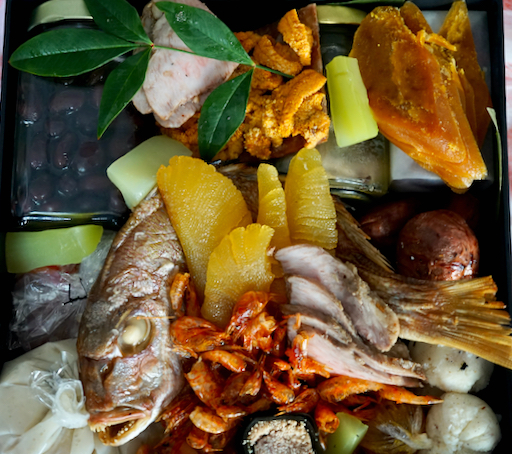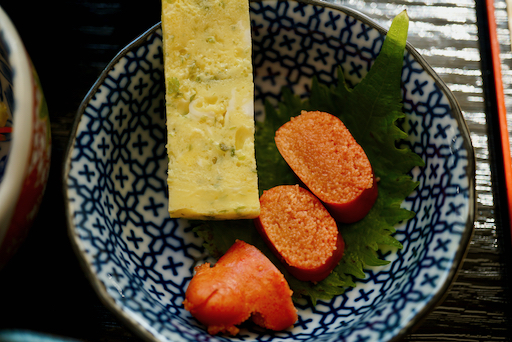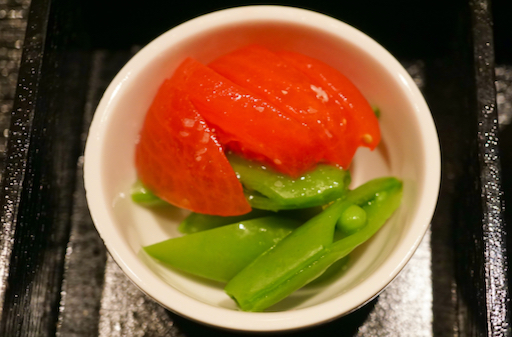Tuesday, March 15, 2022
Uni shutou with salmon roe 雲丹酒盗いくら入り
Monday, January 10, 2022
New Year 2022 Jan 3 Salmon three ways 一月三日鮭尽し
We have been enjoying the items from the Sushi Taro osechi box. After indulging in a serving of wonderful dishes from the box which go perfectly with sake, I served this plate as the “second course”. The red and white fish cake or "kouhaku kamaboko" 紅白蒲鉾 (upper left in the picture) came from the osechi box (they were the last four slices). I made a deep pocket in each and stuffed the pink one with the leftover Maruhide sea urchin shutou 丸秀雲丹の酒盗 topped with a dab of wasabi. I topped the white one with Ikura marinated in soy sauce イクラの醤油ずけ topped with strips of nori.
The remaining items were all different salmon dishes which I prepared for New Year. Starting from right upper, clock wise, is salmon nanban 鮭の南蛮漬け、Russian marinated salmon 鮭のロシア漬け, and finally salmon kelp roll 鮭の昆布巻き. These three salmon dishes all have different textures and flavors. For the salmon nanban, the salmon was dredged in flour and fried before being marinaded in sweet vinegar which gave it a bit firmer texture. The Russian marinated salmon started out as thin strips of raw salmon marinated in sake, vinegar and oil without any sweetness. This year I something different. I added dijon mustard to the marinade and emulsified it with the “motor boat” emersion blender. As a result the oil didn’t separate or solidify. Also, the salmon did not “over cook” and had a lovely soft texture. Finally the salmon kelp roll was simmered for sometime in seasoning broth, producing a yet different soft and moist texture. These are wonderful to enjoy with sips of sake.
Friday, January 7, 2022
Sushitaro Osechi 2022 寿司太郎お節 2020
This is a picture of the upper box. I am not going into the details but its all good stuff. Many items are hidden behind and under the items on the top.
This was what we ate from the box the evening of January 2. I just served whatever caught my eye. This round was mainly items that go well with sake.
In this three compartment plate, I served (from left to right) “Mushi uni” 蒸し雲丹 or steamed sea urchin, “Uni shutou with yuzu-chilli” ウニ酒盗 柚子胡椒 from Maruhide 丸秀 and “ikura shouyu-zuke” いくら醤油ずけ soy marinated salmon roe. I added wasabi-soy sauce to the steamed uni and made a cucumber boat to contain the ikura. All perfect for sake.
After these, we had simmered vegetables (again lightly warmed in the microwave) and finished with a mayo-biscuit my wife made that afternoon (subject of another post).
Saturday, January 1, 2022
Happy New Year 2022 明けましておめでとう 2022.
Happy New Year 2022! The pandemic still persists with the Omicron variant making it debut and spreading so quickly just when we thought things were starting to come under control and using a quote from the movie Jaws "it was safe to go back in the water again". In any case, both my wife and I took all the precautions; being vaccinated and boosted. We sincerely hope we can get past this soon.
This is the year of tiger according to Chinese/Japanese zodiac signs. We thought we had a larger tiger figurine but these are what we had. The two shown below look somewhat like cats rather than tigers.
Sunday, December 5, 2021
Hiyaoroshi #2 and Uni tasting 冷やおろし#2、海水うに
This is a continuation of our exploration of the “Hiyaoroshi” sake ひやおろし we recently acquired (with a complementary uni tasting on the side.) As I mentioned before, this sake is seasonal; only available in autumn and until recently, the only way to enjoy this seasonal sake was to visit Japan in autumn. This fall, however, thanks to Tippsy sake, we could enjoy hiyaoroshi here in U.S. So far, we’ve tried 5 different hiyaoroshi sakes. All of them were “Junmai” class but the aging process really “kicked them up a notch” making them taste superior to regular Junmai sake. All the hiyaoroshi we tasted had rich savory and complex flavors with some fruity floral characteristics. We tasted (from left to right) three sakes; “Ooyama”, “Gokyo” and “Kisoji”.
1. Ooyama 大山 (meaning “big mountain”) is from Yamagata prefecture 山形県 (which is famous for many excellent and “cult” sakes including “Juyondai” 十四代). The brewery is “Katou Kahashirou” 加藤嘉八郎酒造. This sake is called “Tokubetsu junnmai” 特別純米. “Tokubetsu" means “special”. My understanding is that this designation does not have an official definition, but usually the rice is polished to 60%. This is the same level of polishing as “Ginjou” 吟醸酒. So, by definition, this type of “Tokubetsu junmai” could also be sold as “Ginjo”. It is up to the brewer to decide what to call it. Junmai is usually characterized by robust and rich flavors while ginjo is characterized by more elegant crisp fruity flavors. So, depending on the aim of the particular sake, the brewer could call it either way. We really like this sake. Quite rich and dry with some acidity.
Wednesday, September 8, 2021
Renkon "hasami-age" with avocado and cod roe アボカドとたらこのレンコンはさみ揚げ
This is a rather unique and good dish. The renkon remains crispy and the avocado creamy with salty and lightly spicy (I did not add too much Sriracha) tarako flavors come through.
One segment of fresh renkon, peeled and sliced (about 1/2 to 2/3 inch thick, I got a total of 12 slices).
6 perilla leaves
One sac of tarako, roe scraped out from the sac (#1)
One ripe avocado, stone and skin removed (#2)
Sriracha or other hot sauce to taste
For tempura batter
1/4 cup cake flour plus a bit more for dredging the renkon slices
1/4 cup carbonated water
Oil for deep frying
Directions:
Mash and mix the avocado, tarako with the sriracha hot sauce to taste (#3 and #4).
Lightly dredge the renkon slices. Put on a perilla leaf and then 1/6 (2-3 tsp) of the stuffing (#5).
Top the stack with another slice of renkon. Press lightly to secure (#6).
Saturday, July 31, 2021
Nagaimo dressed in cod roe 長芋の鱈子和え
1 inch segment of nagaimo, skinned, sliced and cut into fat match sticks.
1 tsp sake
One sac of salted tarako, cod roe
Perilla leaves and nori chiffonade for garnish
Direction:
Soak the nagaimo sticks in water with a splash of rice vinegar and gently wash to remove surface sliminess. Blot dry using a sheet of paper towel.
Remove the roe from the sac using the back of the knife and mix it with 1 tsp of sake. Taste and if not salty enough, add soy sauce (mine was salty enough).
Dress the nagaimo and garnish it with the perilla.
Sunday, June 6, 2021
Raised Buckwheat Blini cooked in a “platar”
Ingredients:
For Blini (makes about 21 blini)
1 1/2 cup milk
4 Tbs. (1/2 stick) butter
2 tsp. yeast
2/3 cup AP flour
2/3 cup buckwheat flour
2 Tbs. sugar
1 tsp. salt
3 large eggs, lightly beaten
For Blini (recipe X2) (mix in the 6 cup pyrex mixing cup so the batter can be poured rather than scooped into the cooking cups.)
3 cup milk
4 tsp. yeast
1 1/3 cup AP flour
1 1/3 cup buckwheat flour
4 Tbs. sugar
2 tsp. salt
6 large eggs, lightly beaten
For topping (everything is to taste and depends on the number of pancakes being served. Also anything can be used. This is just what we came up with.)
sour cream (to taste)
2 eggs, scrambled
1 Tbs. Ikura (salmon eggs) or caviar
Chives finely chopped
Directions:
For the Blini: Melt the butter in the milk. Let it cool to about 105 to 115 degrees. Mix the dry ingredients (yeast through salt) in another bowl. Pour the cooled milk mixture over the dry ingredients mixing until just combined. Cover the bowl with plastic wrap and let it rise in a warm place until doubled in volume (about 1 hour) (#1 in the 3rd group of pictures). Once it has risen either make the pancakes immediately or refridgerate covered for up to 24 hours. (We made the batter after dinner and refridgerated it over night). If refridgerated let it stand at room temperature for 20 minutes (#2). Then deflate the batter and whisk in the eggs lightly beaten.
Now, I am providing the details of how I cooked blini in the platar. This is for our future reference because this requires some finesse. First, I took out the planar and washed it with hot water (no soap), dried it by heating it on the stove and coated each of the 7 wells with olive oil using a paper towel (#3). I preheated the pan on low flame for 5 minutes then used a small ladle (second smallest ice cream scoop) add the batter, half filling the wells (#4). I continued to cook until the surface of the pancake showed bubbles and looked dry (5-7 minutes). Then came the challenge of flipping them. According to my wife, the directions in the JOC said flip the pancakes over using a skewer. But that proved entirely too simplistic. After some experimentation I came up with a method of loosening the blini by running the tip of a dinner knife around the perimeter of the well, then inserting the knife tip under the bottom of the blini to pry it loose. Then with the knife under the blini and a bamboo skewer inserted into the top I flipped it (#5). As I repeated the process I got better and could flip the pancake without damaging the side. But I noticed that the 6 wells surrounding the center well had uneven heat and only the outer half got browned (#5). So with the next batch, I released the blini before they were ready to flip and turned them180 degrees in the well then cooked them for a few more minutes before flipping them over. In the next batch, the first side was more evenly browned (#6). In any case, when all was said and done, we had at least a few perfect blinis (#7= top and #8=bottom).
This is the height of decadence. The blini had a soft thick texture and a very pleasing robust rustic flavor from the combination of buckwheat flour and yeast. The sour cream, eggs and salmon caviar were an excellent combination with complementary creamy texture. The burst of saltiness from the ikura at the end of the bite was a perfect finale. This is how we will be making blini in the future. Next stop crumpets in the platar.
Monday, May 31, 2021
Tarako from Korean grocery store Hmart 焼きたらこ
Lightly grilled salted "tarako" たらこ cod roe is not really a new dish as I posted it many years ago, but it is a very common dish in Izakaya and goes perfectly well with sake. I usually get tarako (frozen) from our Japanese grocery store, but this time I got it from Hmart, the Korean grocery store, through Instacart. The groceries were delivered while I was not at home so my wife received them. During a subsequent phone call, she mentioned that it was not a completely successful grocery run since the three types of fresh mushrooms and the mackerel we ordered were not available. The good news was that the "tarako" did arrive. She said something was wrong, however, because it was covered with a red goopy stuff and suggested that maybe the little egg sacks had somehow ruptured spilling their contents. (Not good!) So when I got back in the evening and inspected the tarako I found it was coated with a Korean hot sauce "gochujang". We were both relieved and had a good chuckle. Since we are not into very hot spicy food, I quickly rinsed off the hot sauce. I made "Tarako" pasta たらこスパゲッティwith it and it was just fine. I made the dish shown below from the last sac of tarako. I just cooked it in the toaster oven until the surface was cooked but the insides were still raw. I served it with a Dashimaki omelet だし巻き I had made.
Saturday, February 27, 2021
One spoonful appetizers and more
Monday, February 15, 2021
One spoonful appetizers a.k.a baby food for adults 一口スプーンの前菜第二弾
Ingredients:
Broccoli stem, hard bottom removed and hard skin removed (I used stems of two broccoli heads), cut into small cubes.
One medium onion, finely diced
One parsnip (or maybe a potato), skinned, cut into small cubes.
1/2 cup of chicken broth or more depending on the consistency of the puree (I used Swanson's no fat reduced salt)
1 tsp unsalted butter and 2 tbs olive oil
Salt to taste
Two bay leaves (optional)
Directions:
Add the olive oil and butter to the pan on medium flame and sauté the onion until cooked (2-3 minutes).
Add the broccoli stem and parsnip and coat with butter/oil and add the chicken both to cover.
Remove the bay leaves and puree using an immersion blender until smooth (add more chicken broth for desired consistency).
Season with salt
These appetizers are nice. The spoonful is just the right amount for a satisfying gulp. They provide a nice range of flavors although the consistency seems, well consistent. It is lovely and smooth but I can’t help but think of it as sophisticated “baby food for adults”. I’ll have to come up with something different.
Monday, January 25, 2021
A spoonful appetizer 一口スプーン前菜
My wife gave me some new plates and bowls for Christmas which required us to rearrange things to make a room for them. During these activities, we found spoons my wife got for me some time ago which were meant to serve a just one-swallow/bite appetizer. Since they newly resurfaced, I promptly tried a one-swallow/bite appetizer using the spoon. The handles of the spoons are bent so that they can sit on the plate without a handle sticking over the edge. I served this with the last of New Year’s salmon kelp roll and Russian marinaded salmon.
This was quite good. Although our initial cauliflower purée was made with cauliflower cooked in milk, recently I have been making in an abbreviated quick method.
Ingredients:
One small head of cauliflower, florets separated
1-2 tbs unsalted butter
1 cup warm milk
Directions:
Steam the cauliflower using a basket steamer for 10-15 minutes until very soft.
Place the cauliflower in a plastic container for immersion blender
Add more milk for the nice silky consistency if needed.
Add the butter in thick pats
Season with salt and blend until very smooth and silky
This is wonderful way to prepare cauliflower. This purée can be used in many different ways. The smooth texture of the cauliflower purée was a great contrast to the burst of saltiness from the ikura.


















































